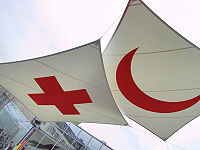Red Cross
 The Red Cross and Red Crescent emblems, the symbols from which the movement derives its name. |
|
| Founded | 1863 (ICRC); 1919 (IFRC) (idea was in 1859) |
|---|---|
| Founder | Henry Dunant, Gustave Moynier |
| Type | Non-governmental organization, Non-profit organization |
| Focus | Humanitarian |
| Location |
|
|
Area served
|
Worldwide |
| Method | Aid |
|
Revenue
|
US$3.6 billion (2010) |
|
Volunteers
|
Around 17 million |
| Website | www.icrc.org |
The International Red Cross and Red Crescent Movement is an international humanitarian movement with approximately 97 million volunteers, members and staff worldwide which was founded to protect human life and health, to ensure respect for all human beings, and to prevent and alleviate human suffering.
The movement consists of several distinct organizations that are legally independent from each other, but are united within the movement through common basic principles, objectives, symbols, statutes and governing organisations. The movement's parts are:
Until the middle of the 19th century, there were no organized and/or well-established army nursing systems for casualties and no safe and protected institutions to accommodate and treat those who were wounded on the battlefield. In June 1859, the Swiss businessman Jean-Henri Dunant traveled to Italy to meet French emperor Napoléon III with the intention of discussing difficulties in conducting business in Algeria, at that time occupied by France. When he arrived in the small town of Solferino on the evening of June 24, he toured the field of the Battle of Solferino, an engagement in the Austro-Sardinian War. In a single day, about 40,000 soldiers on both sides died or were left wounded on the field. Jean-Henri Dunant was shocked by the terrible aftermath of the battle, the suffering of the wounded soldiers, and the near-total lack of medical attendance and basic care. He completely abandoned the original intent of his trip and for several days he devoted himself to helping with the treatment and care for the wounded. He succeeded in organizing an overwhelming level of relief assistance by motivating the local villagers to aid without discrimination.
Back in his home in Geneva, he decided to write a book entitled A Memory of Solferino which he published with his own money in 1862. He sent copies of the book to leading political and military figures throughout Europe. In addition to penning a vivid description of his experiences in Solferino in 1859, he explicitly advocated the formation of national voluntary relief organizations to help nurse wounded soldiers in the case of war. In addition, he called for the development of international treaties to guarantee the protection of neutral medics and field hospitals for soldiers wounded on the battlefield.
...
Wikipedia
